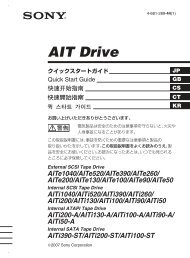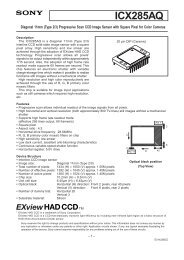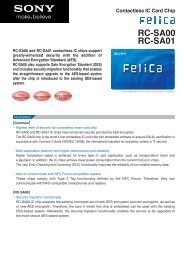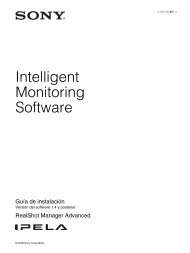PDF [4833KB] - Sony
PDF [4833KB] - Sony
PDF [4833KB] - Sony
You also want an ePaper? Increase the reach of your titles
YUMPU automatically turns print PDFs into web optimized ePapers that Google loves.
The fiscal year ended March 31, 2004 saw<br />
a number of hit titles emerge from both SCE<br />
and other game software developers/<br />
publishers. One was EyeToy: Play, which was<br />
published by SCE and shipped over 3 million<br />
units. Also during the past fiscal year, additional<br />
software has been introduced that<br />
makes possible new ways to enjoy the PS2<br />
platform, including online games and software<br />
with new user interfaces.<br />
In Japan, North America, Europe and the<br />
Republic of Korea, the development of game<br />
software for online gaming is continuing<br />
apace. As of March 31, 2004, a cumulative<br />
total of more than 3.6 million units of network<br />
adapters for PS2, which are required for<br />
online play, had been sold worldwide. The<br />
number of titles available with online gaming<br />
capability has reached approximately 140<br />
worldwide. In recent years, game software<br />
has been extremely well received, and has<br />
been successful at attracting many new users,<br />
by creating features that allow users to enjoy<br />
PS2 in many new ways including USB cameras,<br />
used with EyeToy: Play, and drum-style<br />
controllers, used in the Taiko no Tatsujin<br />
series created by NAMCO Ltd. These new<br />
interfaces are also playing a major role in<br />
attracting new PS2 users.<br />
SCE will continue to propose various new<br />
ways to enjoy PS2, helping it gain further<br />
ground as the standard game platform<br />
among a wide range of users.<br />
PlayStation Portable (PSP), handheld<br />
video game system, to be launched<br />
SCE is planning to roll out a handheld video<br />
game system called PlayStation Portable (PSP)<br />
in Japan in late 2004. PSP is scheduled to be<br />
shipped in the U.S. and Europe in spring 2005.<br />
PSP has a high-grade TFT LCD screen and<br />
will allow users to enjoy game software with<br />
3D computer graphics on a par with PS2<br />
anytime anywhere. PSP’s wireless networking<br />
capabilities will give users access to online<br />
gaming and permit various PSP units to be<br />
linked up into a wireless network—a feature<br />
that should greatly expand available options<br />
for playing games. The medium chosen for PSP<br />
content is UMD (Universal Media Disc) —<strong>Sony</strong>’s<br />
newly developed ultra-compact optical disc.<br />
UMD can store up to 1.8 GB of digital data<br />
and is equipped with the latest copyright<br />
protection technology. This allows UMD to be<br />
used not only for encoding game software<br />
with dynamic moving images but also for<br />
movies, music and other digital content.<br />
SCE intends to promote both PSP and UMD<br />
as new entertainment platforms, giving even<br />
more people worldwide the opportunity to<br />
experience the joy of portable entertainment.<br />
Universal Media Disc (UMD)<br />
PlayStation Portable (PSP)<br />
Generating a new computer<br />
entertainment system<br />
By providing advanced technologies in the<br />
form of development tools and middleware<br />
necessary for the development of new<br />
computer entertainment, SCE is continuing to<br />
enhance the environment for creating new<br />
content and further stimulate creativities of<br />
game creators.<br />
SCE continues to work on further increasing<br />
the popularity of the PS and PS2 platforms.<br />
At the same time by aggressively promoting<br />
PSP, which is scheduled for launch in late<br />
2004, SCE will introduce an even more extensive<br />
and more appealing lineup of software.<br />
SCE is also dedicated to stimulating further<br />
development and growth of the game market<br />
and developing an entertainment market<br />
beyond its conventional boundaries.<br />
Proposing new modes of play—<br />
EyeToy: Play<br />
SCE released EyeToy: Play, a software title that<br />
provides a whole new way to enjoy the PS2 computer<br />
entertainment system, in July 2003 first in<br />
Europe and then, subsequently, in other regions.<br />
Through a USB camera, which connects to the PS2<br />
console, this software allows players to use their<br />
hands, legs and heads to interact with the game,<br />
by placing them on the screen. This hit title has<br />
sold more than 3 million units worldwide, playing<br />
a major role in attracting new users to PS2. SCE<br />
and other game software developers/publishers<br />
are planning to launch a stream of titles compatible<br />
with the EyeToy USB camera.<br />
EyeToy: Play<br />
EyeToy camera<br />
Home Electronics Mobile Electronics Game Entertainment Financial Services Other<br />
47


![PDF [4833KB] - Sony](https://img.yumpu.com/26420643/49/500x640/pdf-4833kb-sony.jpg)













